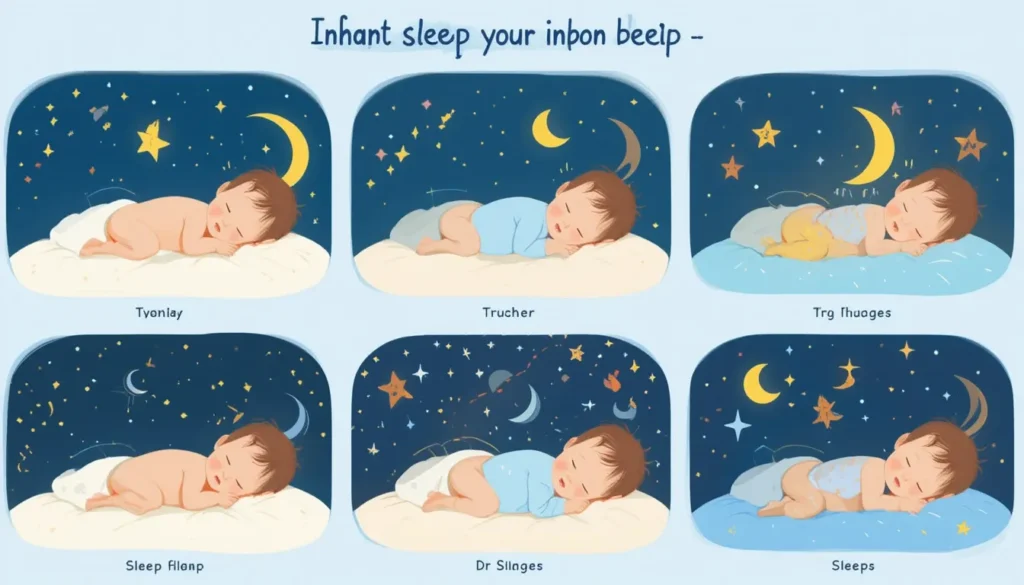Ever feel like you’re navigating bedtime on auto-pilot, hoping your baby finally falls asleep? If so, you’re not alone. Baby sleep training can be one of the most challenging hurdles for new parents, yet it’s also among the most rewarding milestones once you get it right. In this comprehensive guide, we’ll explore proven, research-backed techniques to help your baby sleep through the night. We’ll also debunk common myths, share real-life stories, and give you actionable steps you can start today. Ready to reclaim those peaceful nights?
Why Baby Sleep Training Matters

Sleep training isn’t just about getting more shut-eye for parents—though that’s certainly a plus! It also promotes healthier sleep patterns and development for your baby. Studies suggest that infants who learn consistent sleep habits early on are often happier, more alert during the day, and have fewer nighttime awakenings. According to a report by the American Academy of Pediatrics (AAP), adequate sleep is crucial for a child’s emotional well-being and cognitive growth.
Common Challenges New Parents Face
- Night Wakings: Frequent awakenings can exhaust everyone.
- Irregular Naps: Napping chaos often spills over into nighttime sleep quality.
- Sleep Associations: Babies can develop strong habits around rocking or feeding to fall asleep, making self-soothing difficult.
- Inconsistent Routines: Life can get in the way, but inconsistent bedtime routines often result in restless nights.
Understanding Your Baby’s Sleep Cycle

To tackle sleep training effectively, it helps to understand what’s happening in your baby’s little brain during sleep. Babies go through sleep cycles that include both REM (rapid eye movement) and NREM (non-rapid eye movement) stages.
- Light Sleep (Stage 1, NREM): Your baby may drift in and out of sleep, easily awakened by slight noises.
- Slightly Deeper Sleep (Stage 2, NREM): Heart rate slows, and your baby’s body temperature decreases.
- Deep Sleep (Stage 3, NREM): The stage where body restoration happens; it’s harder to wake a baby during this phase.
- REM Sleep: Brain activity ramps up, which is crucial for brain development. You might notice fluttering eyelids and minor twitches.
Infant sleep cycles are shorter than those of adults—around 50-60 minutes long, compared to our 90-minute cycles. This is why babies commonly wake up multiple times during the night. Understanding these stages can help you gauge when to put your baby down to sleep and how to respond when they stir.
Popular Baby Sleep Training Methods

There’s no one-size-fits-all method for sleep training. What works for one baby might not work for another. Below are some of the most popular approaches, along with practical tips to help you decide which might be best for your family.
1. The Ferber Method (Gradual Extinction)
Dr. Richard Ferber’s approach, often called “graduated extinction,” involves allowing your baby to self-soothe and learn to fall asleep independently. You check on them at increasing intervals, offering reassurance without picking them up.

- How It Works
- Put your baby down sleepy but awake.
- Wait a set amount of time (e.g., 3 minutes) before going in to reassure if they cry.
- Extend the waiting interval gradually over several nights.
- Pros: Encourages self-soothing, often shows results within a week.
- Cons: Listening to a baby cry can be tough emotionally.
Real-Life Example: My friend Sarah tried the Ferber Method with her 6-month-old after weeks of sleepless nights. The first two nights were rough—her baby cried for about 15 minutes before falling asleep. By the fourth night, the crying lasted just 2 minutes. After a week, her baby slept through the night for the first time.
2. The Chair Method (Fading Method)
If the Ferber Method feels too intense, the Chair Method offers a gentler alternative. You place a chair next to the crib and gradually move the chair farther away each night as your baby falls asleep.
- How It Works
- Night 1: Sit close to the crib and soothe your baby verbally if they fuss.
- Night 2: Move the chair a bit further away, still offering occasional reassurance.
- Night 3 and onward: Keep moving the chair until you’re no longer needed in the room.
- Pros: Less crying, more parental involvement.
- Cons: Can take longer to show results, requiring patience.
3. Pick-Up/Put-Down Method (No-Cry Solution)
Developed by Tracy Hogg (“The Baby Whisperer”), this method focuses on minimal tears. When your baby cries, pick them up for comfort, then place them back in the crib once they calm.
- How It Works
- Lay your baby down awake.
- If they fuss, pick them up briefly to comfort but put them back down before they fall asleep in your arms.
- Repeat until they learn to self-soothe.
- Pros: Gentle and interactive, helps build trust.
- Cons: Time-consuming and can be exhausting if your baby cries frequently.
4. Co-Sleeping and Responsive Parenting
Some parents prefer a more attachment-based approach, where baby sleeps in close proximity (same bed or same room). Responsive parenting emphasizes meeting the child’s needs swiftly.
- How It Works
- Co-sleep (following safe sleep guidelines) or keep the crib in the same room.
- Respond promptly when the baby wakes.
- Gradually phase out nighttime feedings and soothing.
- Pros: Fosters closeness, can facilitate breastfeeding.
- Cons: Transitioning baby to a separate room later might be challenging; not all pediatricians recommend co-sleeping due to safety concerns.
Creating the Perfect Sleep Environment

A conducive environment can significantly improve sleep training success. Here are some practical tips:
- Room Temperature: Keep it between 68–72°F (20–22°C) to ensure comfort.
- Lighting: Use blackout curtains or dim lights to signal bedtime.
- White Noise Machine: The gentle hum can mask sudden noises.
- Bedding & Sleepwear: Ensure the crib is free from loose blankets or pillows. Consider a sleep sack for safety and warmth.
- Scent Association: Lightly using a soothing lavender spray ( pediatrician-approved ) can signal relaxation, but ensure no allergy concerns.
Pro Tip: Overstimulation can be a big sleep disruptor. Try a quiet, low-energy activity like reading or soft music before bedtime to help your baby wind down.
Routines and Consistency

Your baby thrives on predictability, so establishing a bedtime routine is crucial. Consistency sends a clear message that sleep time is approaching.
Step-by-Step Bedtime Routine
- Bath Time: Warm water and gentle soap help relax your baby’s muscles.
- Massage: A quick, soothing baby-safe lotion massage can calm nerves.
- Cozy Pajamas: Choose comfortable, weather-appropriate sleepwear.
- Story or Lullaby: Reading a short book or singing softly signals the brain it’s time to wind down.
- Feeding: Offer a final feeding if part of your schedule—just avoid letting them fall fully asleep during this.
- Dim the Lights: Indicate bedtime visually by lowering the lights.
- Crib Placement: Lay your baby down when they’re drowsy but still awake.
Rhetorical Question: Can you imagine how peaceful your nights would be if your little one recognized all these steps as cues for sleep?
Overcoming Setbacks and Night Wakings

Even the best-laid plans can go awry. Babies, especially those under one year, experience multiple developmental leaps—teething, growth spurts, illness—that may interrupt sleep patterns.
Be Prepared for Regression
Sleep regressions often occur at around 4, 6, 8, and 12 months. When these hit, you might notice increased fussiness and nighttime wake-ups.
- Check Basic Needs: Is your baby hungry, wet, or uncomfortable?
- Reinforce Your Routine: Don’t abandon your established bedtime schedule.
- Offer Extra Comfort: Teething gels, cuddles, or a soft teether can help.
- Stay Patient: Regressions are temporary; your consistency will pay off.
When to Seek Professional Help
If your baby shows signs of persistent sleep issues—like difficulty breathing, chronic restlessness, or extreme fussiness—you may want to consult a pediatrician. According to the Mayo Clinic, sleep disorders are rare in infants but can occur. Trust your instincts and seek medical advice if you suspect something more serious.
Real-World Sleep Training Success Stories

Rachel’s Transformation
Rachel, a first-time mom, struggled for months with her daughter’s erratic sleep schedule. She decided to try the Chair Method:
- Week 1: Rachel placed a chair right next to the crib. Her daughter initially cried for 10 minutes before settling down.
- Week 2: Rachel moved the chair halfway across the room. Her daughter fussed less, about 5 minutes, before calming down.
- Week 3: Rachel didn’t need the chair—her daughter quickly fell asleep within 2 minutes after being placed in the crib.
Now, bedtime takes just 20 minutes, and both mom and baby are getting the rest they need.
Jacob’s Gentle Approach
Jacob, a dad of twin boys, wanted a no-cry approach. He opted for Pick-Up/Put-Down:
- Night 1: Each time his boys cried, he picked them up briefly, then set them back down drowsy.
- Night 2: They required fewer pick-ups.
- Night 3: Cries were replaced by coos, and both boys slept in 4-hour stretches.
After two weeks, the twins were sleeping through the night—no tears required.
Actionable Tips to Maximize Sleep Training Success

Below are some additional strategies to help you nail your baby’s sleep routine.
- Keep a Sleep Journal
- Track naps, bedtime, night wakings, and morning wake-up times.
- Identify patterns or triggers for wakefulness.
- Communicate with Your Partner
- Divide and conquer nighttime duties.
- Consistency across caregivers is essential—mixed signals can confuse your baby.
- Use Positive Reinforcement
- Gentle pats or words of encouragement like “You’re doing great!” can soothe.
- Avoid negative language or frustration, even on tough nights.
- Mind the Daytime Schedule
- An overtired baby actually sleeps worse at night.
- Ensure your baby gets enough daytime naps based on their age.
- Stay Adaptable
- Every baby is unique; what worked last month might need tweaking this month.
- Don’t be afraid to switch methods if your gut says it’s not working.
Further Reading
- How to Create a Safe Nursery Environment for Your Baby (If you have a blog or site section on nursery safety)
- American Academy of Pediatrics – Official guidelines on infant sleep safety.
- Mayo Clinic – Additional health advice and developmental milestones.
- National Sleep Foundation – Research-based sleep recommendations for different age groups.
Conclusion
Mastering baby sleep training isn’t just about getting more rest (though that’s a huge perk!); it’s also an investment in your baby’s overall well-being. By understanding sleep cycles, choosing a method that suits your parenting style, and setting a consistent routine, you can create a nurturing environment where restful nights become the norm rather than the exception. Sleep training is a journey filled with trial, error, and small victories along the way. Embrace each milestone, learn from setbacks, and celebrate every peaceful night.
Ready to tuck in your baby for a blissful night’s sleep? Try out the method that resonates most with you, and don’t forget to share your experiences or any questions in the comments. Your insights might just help another sleep-deprived parent find hope!
FAQs
Q1. When Should I Start Sleep Training My Baby?
Most experts suggest starting between 4–6 months, when your baby is developmentally ready to learn self-soothing. Consult your pediatrician if you’re unsure.
Q2. Is Letting My Baby Cry Harmful?
A bit of fussiness is normal as babies adjust to new routines. Short, controlled crying periods (as in the Ferber Method) are generally not harmful. However, if you’re uncomfortable, there are gentler approaches to try.
Q3. How Long Does Sleep Training Usually Take?
Depending on the method, results can appear in as little as a week or may take several weeks. Consistency is key, so stick with it even if progress feels slow.
Q4. Can I Sleep Train While Breastfeeding?
Absolutely! Many breastfeeding mothers successfully sleep train. Aim to separate feeding from the act of falling asleep. For instance, feed your baby, then read a short story before placing them in the crib.
Q5. What If My Baby Shares a Room with Siblings?
Create a peaceful, separate sleep space or use a partition. Stick to a set bedtime and routine so all children become accustomed to sleeping at similar times.
Q6. Should I Use A Pacifier During Sleep Training?
Pacifiers can soothe some babies. The AAP generally considers them safe for infants over one month (to establish breastfeeding first). Just be prepared to reinsert it if your baby relies on it to fall asleep.
Q7. My Baby Still Wakes Up at Night—Am I Doing Something Wrong?
Not necessarily! Babies naturally have shorter sleep cycles. As long as they learn to self-soothe, these awakenings should become less frequent over time. Stay patient and continue reinforcing positive sleep habits.
Did This Guide Help You?
If you found value in these tips, share this article with a friend or fellow parent who’s struggling with sleepless nights. Feel free to leave a comment below about your journey; we’d love to hear from you!
(Note: This article is for informational purposes and does not replace professional medical advice. Always consult a qualified healthcare provider for concerns about your baby’s sleep.)
